

Museum of Childhood. Collection of the old toy. Collecting Childhood Blog Assistant Curator Alice Sage blogs about some of the discoveries the collections team make in the course of researching the collection.
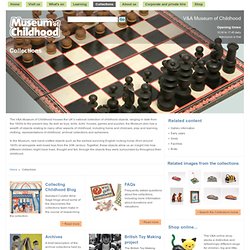
Read more FAQs Frequently asked questions about the collections, including more information about donations and valuations. Read more Archives. Natural History Museum. Red Zone. Floor Plans. Gallery Announcements. Gallery highlights. Green Zone. Dinosaurs. Orange Zone. Tate Modern. Entry details Entry to the collection remains free for everyone. Advance booking is recommended but tickets are often available on the door. Exhibition entry is paid and requires a timed ticket: Visitors with a disability pay a concessionary rate, and entrance for companions is freeMembers and Patrons have free entry to exhibitions but must book a timed ticket before visitingUp to four children aged 11 and under go free per parent or guardian£5 family child tickets are available for children aged 12–18 years For more information see our Booking and Ticketing FAQs.
Entrance Entry is via the Turbine Hall ramp and exit via Level 1. Bag size policy Bags and items larger than cabin bag size (55cm x 40cm x 20cm) are not permitted in the gallery. Security We take security very seriously and work closely with {*style:<a href=' Project Servator teams{*style:</a>*}. Deconstruction. Virtual Reality. The computer scientist Jaron Lanier popularised the term virtual reality in the early 1980s. Virtual reality environments are usually visual experiences, displayed on computer screens or through special stereoscopic displays. Some simulations include additional sensory information such as sound through speakers or headphones. Explorations into virtual reality by artists began in a relatively modest way. Piccadilly Circus.
The Circus lies at the intersection of five main roads: Regent Street, Shaftesbury Avenue, Piccadilly Street, Covent Street and Haymarket.

It was created by John Nash as part of the future King George IV's plan to connect Carlton House - where the Prince Regent resided - with Regent's Park. The creation of Shaftesbury Avenue in 1885 turned the plaza into a busy traffic junction. This made Piccadilly Circus attractive for advertisers, who installed London's first illuminated billboards here in 1895. For some time the plaza was surrounded by billboards, creating London's version of Times Square, but Eros statue. London Eye. Piccadilly Circus. Un article de Wikipédia, l'encyclopédie libre.
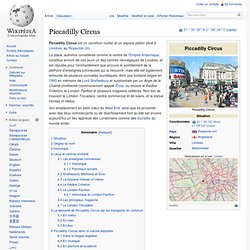
Piccadilly Circus est un carrefour routier et un espace piéton situé à Londres, au Royaume-Uni. La place, autrefois considérée comme le centre de l'Empire britannique, constitue encore de nos jours un des centres névralgiques de Londres, et est réputée pour l'enchantement que procure le scintillement de la pléthore d'enseignes lumineuses qui la recouvre, mais elle est également entourée de plusieurs curiosités touristiques, dont une fontaine érigée en 1893 en mémoire de Lord Shaftesbury et surplombée par un Ange de la Charité chrétienne (communément appelé Éros), ou encore le théâtre Criterion, le London Pavilion et plusieurs magasins célèbres. Non loin se trouvent le London Trocadero, centre commercial et de loisirs, et la statue Horses of Helios. Situation[modifier | modifier le code] Plan de Piccadilly Circus et de ses environs. Origine du nom[modifier | modifier le code] Historique[modifier | modifier le code] Piccadilly Circus en 1896.
British Museum. Pre-Roman Italy. The rugged hills, mountain ranges and rivers of Italy led to its peoples being naturally divided and until the first millennium BC each group developed in its own distinct way.
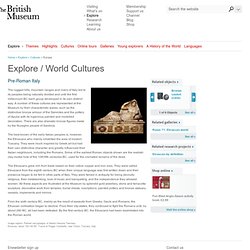
A number of these cultures are represented at the Museum by their characteristic wares, such as the distinctive bronze armour of the Samnites and the pottery of Apulia with its ingenious painted and modelled decoration. There are also dramatic bronze figures made by the Nuraghic people of Sardinia. The best known of the early Italian peoples is, however, the Etruscans who mainly inhabited the area of modern Tuscany. They were much inspired by Greek art but had their own distinctive character and greatly influenced their Italian neighbours, including the Romans.
Roman Britain. In AD 43, Britain became a province of the Roman Empire when it was invaded by an army under the emperor Claudius.
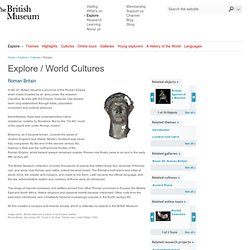
Its links with the Empire, however, had already been long established through trade, population movement and political alliances. Nevertheless, there was understandably native resistance, notably by Boudicca. But by the 70s AD, much of the island was under Roman control. Polynesia. The islands of the eastern Pacific are known as Polynesia, from the Greek for ‘many islands’. They lie across a vast stretch of ocean from Hawaii in the north, to New Zealand in the south and Easter Island in the east. The western Polynesian islands of Fiji and Tonga were settled approximately 3,000 years ago, whilst New Zealand was settled as recently as AD1200. In the past, Polynesians were skilled navigators and canoe builders, creating double-hulled vessels capable of travelling great distances.
Their societies were hierarchical, with the highest ranking people tracing their descent directly from the gods. These gods were all powerful and present in the world. Today, Polynesian culture continues to develop and change, partly in response to colonialism. Aztecs (Mexica) During the twelfth century AD the Mexica were a small and obscure tribe searching for a new homeland.
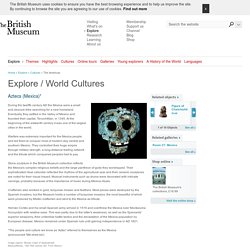
Eventually they settled in the Valley of Mexico and founded their capital, Tenochtitlan, in 1345. At the beginning of the sixteenth century it was one of the largest cities in the world. Warfare was extremely important for the Mexica people and led them to conquer most of modern-day central and southern Mexico. They controlled their huge empire through military strength, a long-distance trading network and the tribute which conquered peoples had to pay. Iron Age. The Iron Age is the period of European history that dates from around 800 BC to the Roman Conquest when iron was first used instead of bronze to make tools and weapons.
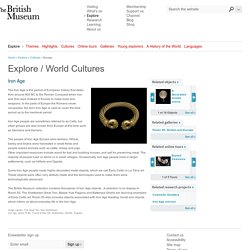
In the parts of Europe the Romans never conquered, the term Iron Age is used to cover the time period up to the medieval period. Iron Age people are sometimes referred to as Celts, but other groups are also known from Europe at this time such as Germans and Iberians. The people of Iron Age Europe were farmers. Wheat, barley and beans were harvested in small fields and people reared animals such as cattle, sheep and pigs. Other important resources include wood for fuel and building houses, and salt for preserving meat. Some Iron Age people made highly decorated metal objects, which we call Early Celtic or La Tène art. The British Museum collection contains thousands of Iron Age objects. Image caption: The Great Torc from Snettisham Iron Age, about 75 BC. Ancient Egypt. Towards the end of the fourth millennium BC several independent city-states were unified to form a single state, marking the beginning of over 3,000 years of pharaonic civilisation in the Nile Valley.
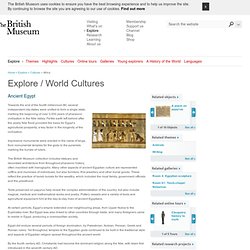
Fertile earth left behind after the yearly Nile flood provided the basis for Egypt’s agricultural prosperity, a key factor in the longevity of the civilisation. Impressive monuments were erected in the name of kings, from monumental temples for the gods to the pyramids marking the burials of rulers. The British Museum collection includes statuary and decorated architecture from throughout pharaonic history, often inscribed with hieroglyphs. Many other aspects of ancient Egyptian culture are represented: coffins and mummies of individuals, but also furniture, fine jewellery and other burial goods. Ancient Rome. In legend Rome was founded in 753 BC by Romulus, its first king.
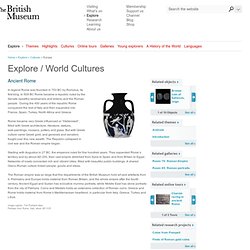
In 509 BC Rome became a republic ruled by the Senate (wealthy landowners and elders) and the Roman people. During the 450 years of the republic Rome conquered the rest of Italy and then expanded into France, Spain, Turkey, North Africa and Greece. Rome became very Greek influenced or “Hellenised”, filled with Greek architecture, literature, statues, wall-paintings, mosaics, pottery and glass. But with Greek culture came Greek gold, and generals and senators fought over this new wealth. Bronze Age. The idea of a “Bronze” Age that succeeded a “Neolithic” or New Stone Age and preceded an “ Iron Age” was developed in the early nineteenth century and was based on the spectacular examples of bronze and gold objects placed in graves, rivers and bogs throughout Europe.
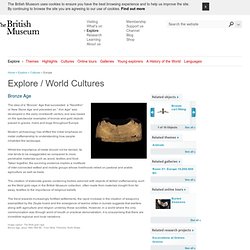
Modern archaeology has shifted the initial emphasis on metal craftsmanship to understanding how people inhabited the landscape. Whilst the importance of metal should not be denied, its role tends to be exaggerated as compared to more perishable materials such as wood, textiles and food. Taken together, the surviving evidence implies a multitude of inter-connected settled and mobile groups whose livelihoods relied on pastoral and arable agriculture as well as trade. Ancient Greece. Cyprus. The island of Cyprus in the eastern Mediterranean was famous in antiquity for its copper mines, fine craftsmanship and luxury goods, and, perhaps most of all, as the birthplace of the Goddess Aphrodite in Greek mythology.
The British Museum holds one of the largest collections of ancient Cypriot objects outside of Cyprus. It illustrates the development of the island from a society of small villages to the rise of urban civilisation between 4000 BC and 1200 BC. By this time, Cyprus was a major source of vital raw materials (especially copper, timber and later iron) and a major trading and industrial centre in close contact with surrounding powers. The galleries also highlight the diverse, multi-cultural nature of the island in the succeeding Iron Age (1000 BC-300 BC): Greeks, Phoenicians and others lived alongside and traded with the local population, shown by inscriptions, imported objects and local imitations. The arrival of St. Byzantine Empire. Medieval Europe. Anglo-Saxon England. The Romans officially withdrew from Britain in AD 410. It is from around AD 450 that we notice large-scale evidence for new and different kinds of people in the archaeological record of the area today called England.
A new burial ritual emerged, in which the dead received grave goods. Dress accessories suggest that a different costume was worn. Weapons and handmade pottery are of previously unseen form and decoration. We also see new house forms and the adoption of a Germanic language that would later become English. Historical sources mention incomers from regions called Angeln and Saxony, so we call these newcomers Anglo-Saxons. By the seventh century a number of Anglo-Saxon kingdoms had formed. Enlightenment Europe. Renaissance Europe. The National Gallery.